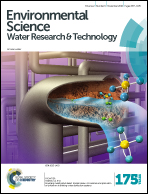Emerging investigators series: using an analytical solution approach to permit high volume groundwater withdrawals†
Abstract
Sustainable water management is paramount to ensuring continued access to fresh water resources. Some states have chosen to use analytical solutions to predict pumping-induced drawdowns and the reduction in groundwater baseflow to streams in an effort to predict negative impacts associated with high volume groundwater withdrawals (HVGWs). In line with this approach, the State of Michigan has developed the Water Withdrawal Assessment Tool (WWAT), which estimates streamflow depletion to evaluate whether a proposed HVGW activity will have an adverse impact on stream ecology. To assess the tool's performance, this study compared calculations for streamflow depletion estimated using the Hunt (1999) solution, as implemented in the WWAT, with those of a numerical groundwater flow model developed in MODFLOW for two different locations in Michigan where HVGW wells have been permitted. In addition, sensitivity and uncertainty analyses were conducted. The results showed that the WWAT, in general, provides a conservative estimate of stream depletion. However, to obtain a more accurate estimate, the type of aquifer (unconfined versus semi-confined) needs to be taken into account. The most critical parameters are the storativity, S, and the streambed conductance, λ. Since S has a fixed value of 0.01 in the WWAT, the role of streambed conductance becomes paramount. Given the paucity of information regarding λ, its estimation merits additional scrutiny.

- This article is part of the themed collection: Emerging Investigator Series


 Please wait while we load your content...
Please wait while we load your content...